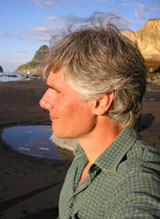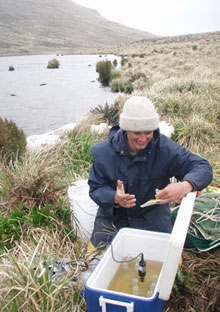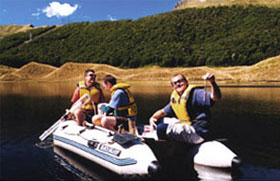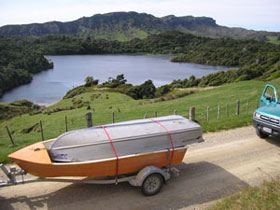Email marc.schallenberg@otago.ac.nz
Phone 64-3-479-8403
Research Interests

- Assessment of anthropogenic impacts on lake ecosystems
- The structure and functioning of planktonic communities along environmental gradients
- Aquatic microbial ecology
- Palaeolimnological reconstruction of historic environments
 Current Postgraduate Students
Current Postgraduate Students
- Sarai Cosgrove (MSc) Late Holocene palaeo-limnological reconstruction of environmental conditions in and around Waituna Lagoon, Southland.
- Brad Caston (PhD) Impacts of land use on primary production in deep, Central Otago lakes
- Tina Bayer (PhD) Potential impacts of climate change on the pelagic food webs of deep, Central Otago lakes
- Ian Smith (MSc) Impacts of runoff contaminated with the nitrification inhibitor, DCD, on nitrogen cycling in a wetland
- Beate Bierschenk (PhD) Niche partitioning amongst four species of mysid shrimps in the Taieri Estuary
- Adrian Lill (PhD) Landscape-scale patterns of ecological structure and functioning of small estuaries

Past Postgraduate Students Research Supervised
- Daniel Thomas (Hons) Estimating molecular and turbulent diffusion of nutrients from the sediments of a shallow coastal lake.
- Theresa Downs (MSc) Trace metal limitation of phytoplankton productivity.
- Michelle Brunton (MSc) Freshwater bryzoans in Dunedin: Distribution, impacts, and potential control methods.
- Tina Bayer (MSc) An investigation of nutrient limitation status and nutrient pathways to Lake Hayes, Otago, as case study for integrated lake assessment.
- Rob Cadmus (MSc) What is, what was, and what will be: Environmental history as a basis for sustainable wetland restoration (2004).
- Katrina Spencer (PGDip) Nutrient limitation of phytoplankton primary productivity in three shallow lakes (2003).
- Catherine Hall (PhD) Effects of tidal intrusions of seawater on the crustacean zooplankton community of a tidal coastal lake (2001).
- Lynda McCann (Hons) The effect of antibiotics in the Taieri Main Drain on bacteria in Lake Waipori (2001).
- Jonathan Copson (Hons) Plankton response to agricultural contaminants and their potential as environmental indicators in Lake Waipori, New Zealand (1998).
- Francis Koon (Hons) The history of the Waipori and Waihola Wetland Complex: An ecosystem through time (1997).
- Mark Leeming (Hons) Autotrophic picoplankton in Lake Wakatipu: relations to nutrient concentrations and ratios (1997).
- Udo Freidrich (PGDip) Ecological importance of particles, phytoplankton and nutrients to heterotrophic bacterial abundance and activity in two oligotrophic New Zealand lakes (1994).
Potential Postgraduate Projects
- Assessment of the potential for food web biomanipulation to improve the water quality of Dunedin's drinking water supplies (MSc)
- Trophic "bottlenecks" and "highways": Determining the foodwebs and energy flows of deep, oligotrophic Central Otago lakes (MSc PhD)
- Is sulphate a neglected key to the problem of eutrophication? The role of sulphate reduction in mediating phosphorus release from anoxic lake sediments
- Does land-derived dissolved organic carbon weaken the trophic coupling between bacteria and phytoplankton in the open waters of lakes and the sea?
- Why does the addition of the plant nutrient, phosphorus, reduce the abundance of pico-phytoplankton in some ultra-oligotrophic lakes? -
- Can dust storms from braided river beds stimulate phytoplankton productivity in ultra-oligotrophic lakes?
- Assessing the past and present contributions of marine nitrogen to coastal lakes and lagoons: Have anthropogenic reductions in seal and sea bird populations reduced marine nitrogen loading?
- I am happy to discuss other project ideas with enthusiastic and motivated students


Marc's Up-to-date publications and citations via Google Scholar
Publications
Smith, I., & Schallenberg, M. (2013). Occurrence of the agricultural nitrification inhibitor, dicyandiamide, in surface waters and its effects on nitrogen dynamics in an experimental aquatic system. Agriculture, Ecosystems & Environment, 164, 23-31. doi: 10.1016/j.agee.2012.09.002 Journal - Research Article
Burns, C. W., Schallenberg, M., & Verburg, P. (2014). Potential use of classical biomanipulation to improve water quality in New Zealand lakes: A re-evaluation. New Zealand Journal of Marine & Freshwater Research, 48(1), 127-138. doi: 10.1080/00288330.2013.838589 Journal - Research Article
Bayer, T. K., Burns, C. W., & Schallenberg, M. (2013). Application of a numerical model to predict impacts of climate change on water temperatures in two deep, oligotrophic lakes in New Zealand. Hydrobiologia, 713(1), 53-71. doi: 10.1007/s10750-013-1492-y Journal - Research Article
Hamilton, D. P., McBride, C., Özkundakci, D., Schallenberg, M., Verburg, P., De Winton, M., Kelly, D., … Ye, W. (2013). Effects of climate change on New Zealand lakes. In C. R. Goldman, M. Kumagai & R. D. Robarts (Eds.), Climatic change and global warming of inland waters: Impacts and mitigation for ecosystems and societies. (pp. 337-366). Oxford, UK: John Wiley & Sons. doi: 10.1002/9781118470596.ch19 Chapter in Book - Research
Özkundakci, D., Hamilton, D. P., Kelly, D., Schallenberg, M., De Winton, M., Verburg, P., & Trolle, D. (2014). Ecological integrity of deep lakes in New Zealand across anthropogenic pressure gradients. Ecological Indicators, 37(Part A), 45-57. doi: 10.1016/j.ecolind.2013.10.005 Journal - Research Article